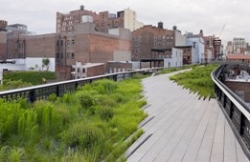The High Line
The Daily Plant : Monday, July 13, 2009
From Threatened Demolition to Public Park: Tracking The High Line's Evolution at Parks (Part I)

Photo Courtesy of Diller, Scofidio + Renfro
On June 9, 2009, the first section of the High Line officially opened to the public. During a decade of tireless advocacy, planning, and development, Parks employees redefined the way we understand and use open space.
“I think this project is a wonderful proclamation that we are going to be innovative, because open space is too important to not have for the residents of New York City,” said Jennifer Hoppa, Administrator for North Manhattan Parks, who was involved with the project as a member of Parks’ division of planning.
Though there were many city agencies, businesses, non-profits, and property owners that helped make the High Line a reality, its opening would not have been possible without the work of hundreds of Parks employees, an effort bolstered by Mayor Michael Bloomberg’s and Commissioner Adrian Benepe’s commitment to the project. The Parks Department, which owns the High Line, decided upon the design and played and essential role in giving the project heels.
Friends of the High Line, a grassroots organization formed in 1999, was the first and most prominent advocate for the preservation of the High Line. In 2002, when Mayor Bloomberg reversed the directive to demolish the abandoned railway, the Parks Department was prepared to engage with Friends of the High Line and other agencies right away.
“The development team—the City and Friends of the High Line—was trying to figure out how to build the park 30 feet up and keep it maintained,” said Mike Bradley, the High Line Administrator. “There was a lot of back and forth about relatively simple things if we were dealing with a park at ground level.”
Once the City decided to assess preserving and effectively reusing the High Line, Deputy Mayor Patricia Harris and all the involved agencies met at City Hall. Among the issues raised were concerns about sustainability and about working with Friends of the High Line, an advocacy group with no prior experience managing an open space.
In addition to working with Friends of the High Line, Parks worked with many City and State agencies throughout the planning process, including the State Historic Preservation Office, NYC Landmark Preservation Commission, Metropolitan Transportation Authority, City Department of Transportation, City Department of Buildings, the Economic Development Corporation, the Mayor’s Development Office, the City Law Department, and the Mayor’s Office for People with Disabilities.
“If one word would sum up this project, it’s ‘coordination,’” Hoppa said.
Joshua Laird, Parks’ assistant commissioner for planning and natural resources, was the initial contact from Parks to make the High Line an official Parks project. Laird helped the Parks Department gain support and overcome major obstacles, including the transfer of development rights on the West side.
There was no saving the High Line without resolving a lawsuit by the Chelsea Property Owners Association, which banded together in favor of demolishing the structure. There is only one piece of public property under the High Line that was originally an abandoned meat market and loading dock, so many negotiations took place involving surrounding residents and businesses who owned private property in the area.
The Parks Department’s mission was to make the owners understand that allowing the High Line to stay in place would add to the value of their property. When the owners agreed to support the plan, Parks worked with the Department of City Planning on crafting the West Chelsea Special District rezoning. Parks also worked with City Hall on getting the Rails-to-Trails agreement with the federal government that allowed CSX Transportation, Inc., the rail owner, to transfer ownership of the property to the City.
Tomorrow we will look back at the search for the High Line’s designer, the security and maintenance plan, and finding the inspiration for the High Line in Paris.
Written by Michael Young
QUOTATION FOR THE DAY
“Small opportunities are often the beginning of great enterprises.”
Demosthenes
(382 B.C. – 322 B.C.)
Check out your park's Vital Signs
Clean & Safe
Green & Resilient
Empowered & Engaged Users
Share your feedback or learn more about how this park is part of a
Vital Park System











